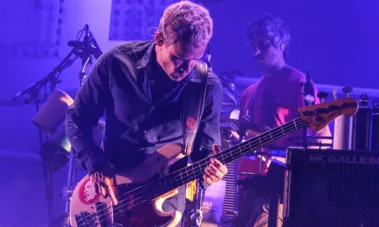
When it comes to bass guitar solos, one name that immediately springs to mind is Flea. The legendary bassist of the Red Hot Chili Peppers has built a reputation for his innovative and electrifying bass lines. But what truly sets Flea apart is his ability to groove. His bass solos are not just about playing a flurry of notes; they encapsulate the essence of groove and rhythm, making them irresistible to listeners. In this master class, we will explore the art of Flea bass solos, dissect his techniques, and uncover the secrets behind his infectious grooves. Whether you're a beginner or an experienced bassist, get ready to elevate your playing to new heights!
The Importance of Groove
Groove, in music, refers to the rhythmic feel and flow that makes a song infectious. It's that irresistible quality that makes you tap your feet or move your body to the beat. Flea bass solos epitomize groove, and mastering this aspect of playing is crucial to becoming a well-rounded bassist.
But what makes a groove so captivating? It's a combination of factors, including timing, phrasing, note choice, and feel. Flea's impeccable timing and ability to lock in with the drummer create a solid foundation for the groove. His distinctive phrasing and note choices add color and character to Flea bass solos, enhancing the overall musical experience.
The Art of Rhythm
Before diving into the intricacies of Flea bass solos, it's essential to develop a strong sense of rhythm. The bass guitar is the backbone of the band, providing the rhythmic foundation. Without a solid grasp of rhythm, it's challenging to achieve that infectious groove.
Start by practicing with a metronome to develop your internal sense of timing. Begin with simple exercises such as playing quarter notes or eighth notes along with the metronome beat. Focus on playing precisely on the beat, gradually increasing the tempo as you feel comfortable.
Next, expand your rhythm vocabulary by experimenting with different subdivisions, such as triplets or sixteenth notes. Explore syncopated rhythms, emphasizing offbeat accents to create a unique groove. Immerse yourself in various musical genres, from funk to reggae to jazz, to expose yourself to different rhythmic feels and styles.
Techniques and Tricks
Now that you have a solid foundation in rhythm, let's dig into the techniques and tricks employed in Flea bass solos.
Slap and Pop
One of Flea's trademark techniques is slap and pop. This technique involves slapping the strings with your thumb and then immediately plucking them with your fingers. It creates a percussive and funky sound that drives the rhythm forward.
To master slap and pop, start by practicing individual slaps and pops, focusing on getting a clean and crisp sound. Gradually incorporate this technique into your playing, combining it with other bass lines and improvisations. Experiment with different hand positions and angles to find what works best for you.
Hammer-Ons and Pull-Offs
Flea employs hammer-ons and pull-offs to add melodic embellishments to his bass solos. These techniques allow for seamless transitions between notes, creating a fluid and legato sound.
To practice hammer-ons and pull-offs, start with simple exercises on a single string. Place one finger on a fret, play the note, and then hammer another finger onto a higher fret without plucking the string. Similarly, practice pull-offs by plucking a string with one finger and then swiftly pulling off to a lower fret. As you become comfortable, incorporate these techniques into your bass solos, and experiment with different combinations and patterns.
Double Stops and Chordal Playing
Another aspect that makes Flea bass solos mesmerizing is his use of double stops and chordal playing. Double stops involve playing two notes simultaneously, creating harmonies and adding depth to the sound.
To incorporate double stops into your playing, start by practicing simple intervals, such as fifths or octaves. Gradually experiment with more complex chord voicings and progressions, exploring different textures and emotions.
Playing with Feel
While the techniques mentioned above are essential in emulating Flea's style, it's crucial not to overlook the importance of playing with feel. Groove is not just about hitting the right notes—it's about expressing emotion and connecting with the music on a deeper level.
Flea's playing exudes energy and passion, and to inject these qualities into your own solos, you must let go of rigidity and embrace spontaneity. Listen to the music around you, internalize the rhythms, and let them guide your playing. Experiment with dynamics, accentuating certain notes or phrases to create contrast and interest.
Remember, groove is a collective effort. Pay close attention to the drummer's kick and snare patterns, locking in with them to create a tight rhythm section. The symbiotic relationship between bass and drums is the heart of groove, so always be mindful of the drummer's cues.
Final Thoughts
Flea bass solos are a master class in groove. By studying and implementing his techniques, as well as developing a strong sense of rhythm and feel, you can elevate your bass playing to new heights. Remember to practice diligently, be patient with yourself, and find joy in the journey toward mastering the art of groove. So embrace the funk, let the rhythm flow, and get ready to captivate audiences with your irresistible bass solos.







Leave a Reply!